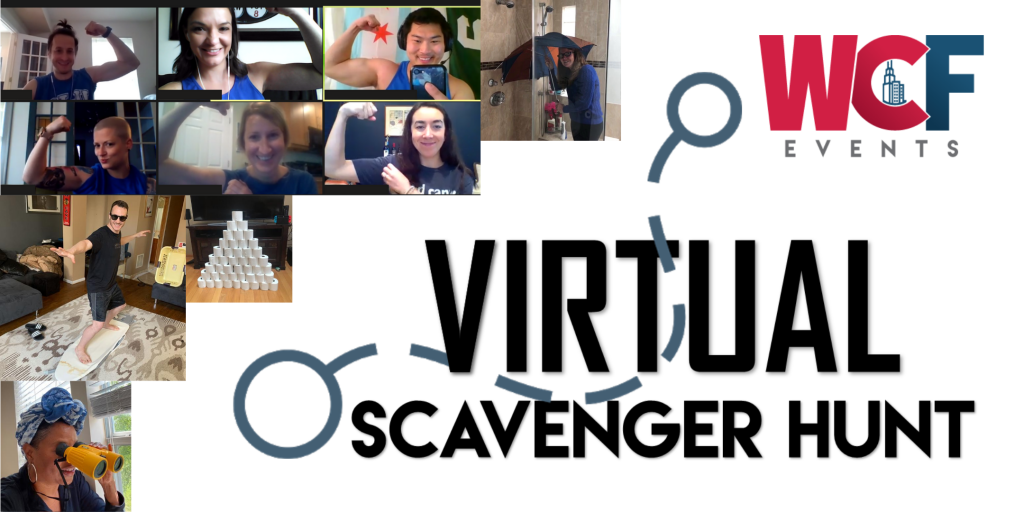If you’re planning a virtual gathering around the holidays or just because, you can keep attendees engaged and entertained with a remote scavenger hunt. This simple, easy activity is a no-fuss addition to any type of informal get-together and offers a low-stakes way for colleagues to compete and bond, making it a fun virtual team building exercise in disguise. To help you host a remote scavenger hunt, we’ve rounded up some tips from event pros.
1. Create a list of items.
Your scavenger hunt list can consist of basic items like Clorox wipes (a pandemic staple) or more abstract things such as “something that someone made for you” or a souvenir from a vacation. This also allows for the participants to share interesting stories about the items.
Rob Davies, president of team building company JAM, says that the host should ask the attendees about their various items to get the conversation going. “Participants can learn more about their friends and coworkers from the game.” For example, “if the item is ‘a picture of yourself as a child,’ ask them about their childhood, where they grew up, where the picture was taken, who else is in the photo, etc.” But he cautions against asking for overly personal or potentially embarrassing items! You can, though, ask virtual guests to search for clothing items like a funny hat or Christmas sweater, which they then can wear for the rest of the game.
He suggests starting with easy items and progressing to more obscure ones. In this way, you’re able to get everyone involved with something that you know they are likely to have. “For each item, consider giving an ‘easy’ and a ‘hard’ category, e.g. a Canadian penny is the easy one (one point), a Canadian penny with a year of 1980 or earlier is the difficult one (two points).”
And for those possibly back in their physical workspace, Mandy Giba, senior operations and marketing manager at Chicago-based WCF Events, says that her team will add in “missions” that include items found in the office.
Keep in mind that single people, married couples, and parents will all have different items in their homes, so try to select items that most folks would have around, so as to not exclude a whole segment of your group. And of course, don’t forget to share the list with attendees. You can do this through the chat feature in your chosen video conferencing platform like Zoom or Google Hangouts or you can share it via Google Docs or email.
2. Set a time limit.
Determine how long each player or team will be allotted to retrieve the items—either one at a time or the entire list. Remember, the free version of Zoom cuts off after 40 minutes, so you’ll want to keep things moving.
3. Figure out the rules.
There are several ways to run a scavenger hunt. You could have each player turn off their camera and search for one item at a time. The first person to turn their webcam back on and show off the correct item, wins points. (The other players can still earn some points for finding the correct item.) Or attendees can round up the entire list of items during a set amount of time and then display all them at the end.
“We find it is more fun and more manageable to put participants into teams. For each item, one person from each team needs to come through for their gang,” Davies explains. “This way everyone gets to participate in the game, but you only need to keep track of one item per team.”
As for the number of participants, Davies says that JAM can accommodate groups of up to 100, but that “the sweet spot is 20 people. That way you have a great amount of energy from the group (and can leave everyone’s microphone on), but the event is still manageable from a planning perspective,” he says.
4. Designate a judge or host.
Just like an IRL hunt, a virtual scavenger hunt works best if there’s a facilitator to explain the rules, keep score, and act as a judge, meaning they can determine if the found item fits the bill. WCF Events uses a scavenger hunt app to help keep track of all the submissions via photos or videos, Giba explains. “Another great feature of the app is the live feed where teams can check out what the other teams have submitted. This way everyone stays accountable and it helps motivate teams to work harder,” she adds.
So if your team is suffering from a case of Zoom fatigue, consider hosting a fun virtual scavenger hunt to help those WFH employees stay connected and energized.

